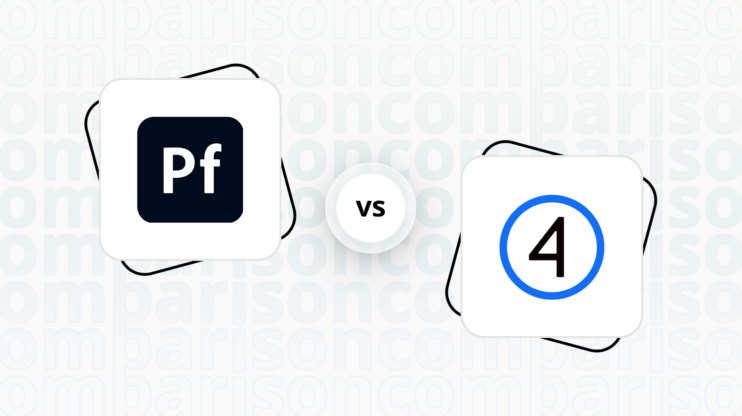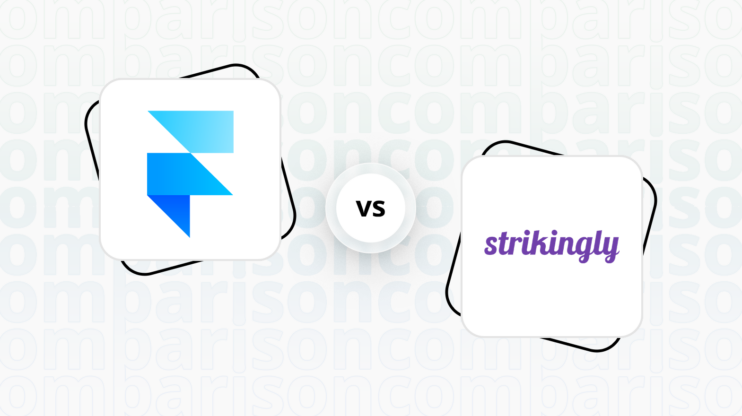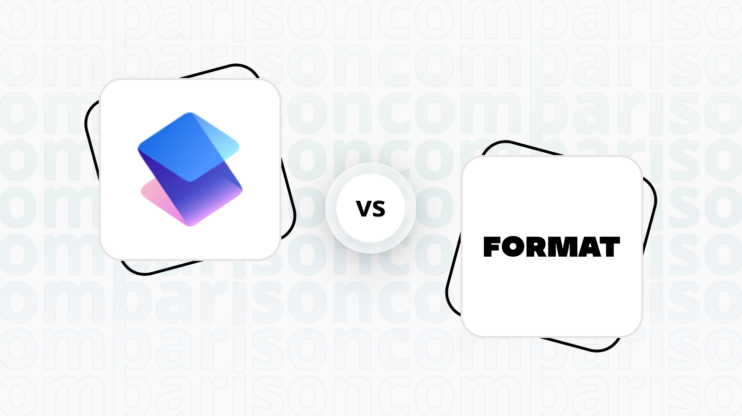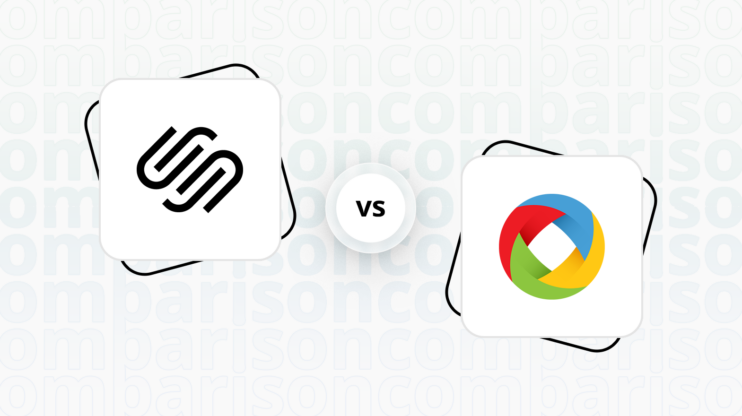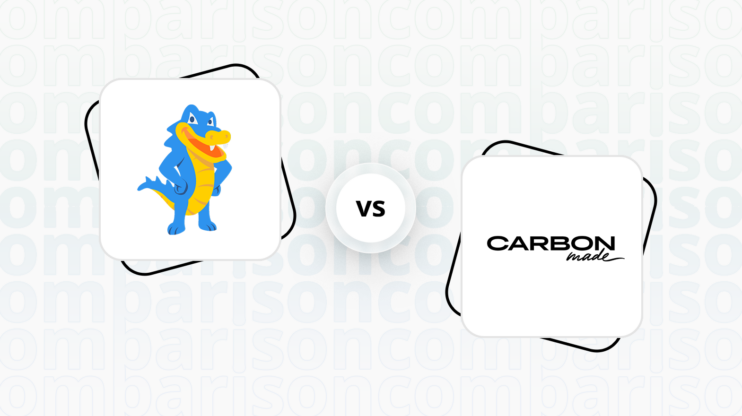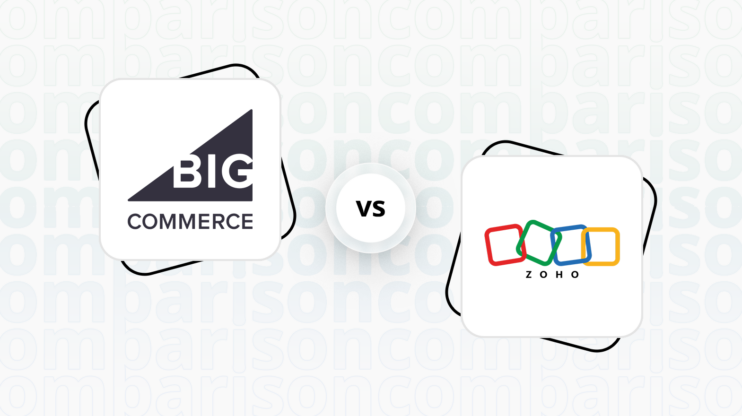Final verdict
Google Sites vs Showit both offer unique advantages, catering to different user needs and preferences.
-
Google Sites (Overall Grade: 5.6/10)
is a straightforward, user-friendly platform ideal for team projects, personal portfolios, and small business websites. It excels in ease of use, integration with Google Workspace, and collaborative features. However, it lacks advanced design customization and ecommerce capabilities, making it less suitable for users seeking extensive creative control or robust online sales functionalities. -
Showit (Overall Grade: 6.4/10)
is designed for creative professionals, offering a high degree of customization and control over website appearance. It stands out with its dual canvas interface for mobile and desktop views, seamless WordPress integration for blogging, and superior design functionalities. While it may be overwhelming for beginners and lacks comprehensive ecommerce features, Showit is an excellent choice for users prioritizing design flexibility and aesthetic appeal.

|

|
|
|---|---|---|
|
Design functionalities & templates |
4.9 |
8.5 |
|
Ease of use |
8.3 |
8.6 |
|
Ecommerce |
1.8 |
4.8 |
|
Website Editors |
7.0 |
8.0 |
|
Product testing options |
6.9 |
8.3 |
|
Price |
8.1 |
7.9 |
|
Hosting quality |
8.2 |
7.3 |
|
Website speed optimization |
3.3 |
5.4 |
|
Plugins and integrations |
6.4 |
5.8 |
|
Marketing features |
2.6 |
7.2 |
|
Customer support |
7.2 |
6.4 |
|
Security |
9.3 |
8.3 |
|
User Management |
7.8 |
6.7 |
Best for ecommerce
 1.8
1.8
 4.8
4.8
Verdict
: Google Sites and Showit are not primarily designed for ecommerce, but Showit offers more flexibility and integration options for ecommerce functionalities.
-
Google Sites
: Google Sites is not built for ecommerce and lacks native ecommerce features. Users must rely on third-party integrations to add ecommerce functionalities, such as embedding payment buttons or linking to external platforms. This makes it less suitable for businesses looking for robust ecommerce solutions. -
Showit
: Showit provides basic ecommerce capabilities through integrations with platforms like Shopify Lite and WooCommerce. It is more suitable for visually oriented websites that prioritize design and aesthetics. While it doesn’t match the comprehensive ecommerce features of dedicated platforms, it offers more flexibility and customization options compared to Google Sites.
Best for informational & business websites
 7.2
7.2
 8.7
8.7
Verdict
: When it comes to creating informational and business websites, Showit takes the lead with its high degree of customization and design flexibility, making it ideal for creative professionals. Google Sites, while user-friendly and integrated with Google Workspace, may not offer the same level of advanced features and design options.
-
Google Sites
: Google Sites is a straightforward, user-friendly platform that integrates seamlessly with other Google services. It is particularly well-suited for team projects, personal portfolios, and small business websites. Its collaborative features and ease of use make it a popular choice for users who need to create functional websites quickly. However, it may lack the advanced design customization options that more experienced web developers might seek. -
Showit
: Showit excels in providing a highly customizable and visually appealing website-building experience. Its drag-and-drop interface and dual canvas design for mobile and desktop views offer a high degree of creative control, making it a favorite among photographers, designers, and bloggers. The platform’s integration with WordPress for blogging adds to its versatility, making it a strong contender for those who want both design flexibility and powerful blogging capabilities. When comparing Google Sites vs Showit, Showit stands out for its design functionalities and ease of use.
Detailed comparison
Design functionalities & templates
Design FunctionalitiesRepresents how well each platform allows for creative design and customization of websites.Score Components:
- Template Variety (30%): Range and quality of design templates.
- Customization (30%): Flexibility and options for design alterations.
- User Interface (20%): Ease and intuitiveness of the design process.
- Responsiveness (10%): Adaptability to different devices and screen sizes.
- Innovation (10%): Unique design features and tools.
 4.9
4.9
 8.5
8.5
🏆
Winner: Showit.
If you’re looking for a platform that offers more creative control, a wide array of design features, and a larger number of templates, Showit is the preferred choice.
Google Sites offers a limited number of templates suitable for various purposes, from personal blogs to business websites, with both free and premium options available. These templates are designed for user engagement, simplicity, and functionality, allowing for customization to meet specific needs. However, compared to other website builders like 10Web or Squarespace, Google Sites might offer less variety in templates and design customization options.
On the other hand, Showit offers a wide variety of templates and designs, catering to diverse aesthetic preferences and business needs. Users can choose from an extensive collection that ranges from minimalist and sleek to bold and artistic, ensuring there’s something for every brand identity. The platform is known for its flexibility and user-friendly interface, allowing for easy customization of templates.
Get a head start on website creation with AI
Create a custom website tailored to your business needs 10X faster with 10Web AI Website Builder!
Ease of use
Ease of useReflects the platform’s overall user-friendliness.Score
Components:
- Learning curve (40%): Quickness and ease of getting started.
- Interface design (30%): Simplicity and intuitiveness of layout.
- User guidance (20%): Quality of tutorials and support.
- Flexibility (10%): Adaptability to various user skills.
 8.3
8.3
 8.6
8.6
🏆 Winner: Showit
. With a score of 8.6, Showit edges out Google Sites (8.3) in terms of ease of use. Showit’s drag-and-drop interface and high degree of customization make it a user-friendly choice, especially for creative professionals. Google Sites, while also user-friendly and integrated with Google Workspace tools, may lack the advanced features desired by more experienced web developers.
Learning Resources
🏆 Winner: Google Sites
. Google Sites offers a wide array of learning resources, from practical guides for educators to comprehensive digital skill development programs for the wider public. Showit also provides a range of learning resources, including a comprehensive training course and a more informal learning hub with videos. However, Google Sites’ integration with other Google services and its emphasis on versatility give it the edge in this category.
For ecommerce
EcommerceMeasures the platform’s effectiveness in supporting online business activities.Score Components:
- Ecommerce themes and templates (20%): Variety and design of templates.
- Product management (25%): Ease of managing and organizing products.
- Payment options (25%): Variety and convenience of payment methods.
- Ecommerce features (20%): Features for managing an ecommerce store.
- Integration (10%): Compatibility with external e-commerce tools and services.
 1.8
1.8
 4.8
4.8
When it comes to ecommerce, both Google Sites and Showit are not primarily designed for this purpose. However, they offer some level of ecommerce functionality through integrations with third-party platforms.

|

|
|
|---|---|---|
|
Ecommerce themes and templates |
0.0 |
2.0 |
|
Product page customization |
0.0 |
2.5 |
|
Payment processing and commissions |
1.0 |
4.0 |
|
POS capabilities |
0.0 |
1.0 |
|
Payment gateways |
2.0 |
4.5 |
|
Product numbers |
0.0 |
3.0 |
|
Additional ecommerce features |
0.5 |
3.5 |
Google Sites ecommerce features:
- Google Sites itself does not have built-in ecommerce features. However, you can integrate ecommerce functionalities into a Google Sites website by embedding third-party tools or widgets, linking to an external ecommerce platform, or using buttons that link to payment processors. For instance, you could use Google Forms for order forms and integrate PayPal or another payment service for transactions. To have a full-fledged ecommerce platform with Google Sites, you’d need to rely on these external integrations or services.
Showit ecommerce features:
- Showit is primarily a website builder focused on design, offering great flexibility and creative freedom, making it ideal for visually oriented websites rather than extensive e-commerce platforms. It includes basic ecommerce functions but lacks the comprehensive ecommerce features found in platforms like Shopify or WooCommerce. However, Showit allows integration of both the mentioned platforms for enhancing ecommerce capabilities. For businesses prioritizing aesthetics and content presentation over robust online sales functionalities, Showit can be a compelling choice.
Ecommerce themes & templates
Neither Google Sites nor Showit offer ecommerce-specific themes or templates. Google Sites does not have any ecommerce templates, and while Showit does not have any ecommerce specific templates, it does offer great flexibility and creative freedom in design, making it ideal for visually oriented websites.
Product page customization
Google Sites lacks any product page customization features, as the products can be listed with embedding third-party platforms, all the customization can be done within the mentioned platforms. Showit has very basic ecommerce capabilities, primarily through its integration with WooCommerce and Shopify.
Payment processing
You can integrate payment gateways into Google Sites using external tools or links, not through native features. This can be done by embedding HTML code for payment buttons from services like PayPal, Square, or Stripe, or by linking to an external checkout page. Third-party eCommerce widgets also offer a way to add payment functionalities. However, Google Sites doesn’t offer the comprehensive eCommerce capabilities that dedicated platforms provide.
Showit supports e-commerce by allowing integration with third-party platforms like Shopify Lite, ThriveCart, WooCommerce, and Podia, rather than offering direct payment processing or POS capabilities. Users can add e-commerce functionalities to their Showit sites using embed codes for “Buy Buttons” or similar features from these platforms. The choice of platform depends on the user’s specific needs, including product type, store size, and budget, as each platform has its own pricing and transaction fee structures. Additionally, the platform supports integration of PayPal pay button, allowing users to pay directly through their PayPal account.
Website Editors
Website EditorsEvaluates the platforms’ website building and editing capabilities.Score Components:
- Customization tools (40%): Range and power of editing features.
- Editor usability (30%): User experience within the editor.
- Design flexibility (20%): Freedom in layout and design changes.
- Update and maintenance ease (10%): Simplicity of updating and maintaining the site.
 7.0
7.0
 8.0
8.0
🏆
Winner: Showit
. Showit, with a score of 8.0, offers a drag-and-drop interface that allows for high customization without coding. It is designed for creative professionals and integrates seamlessly with WordPress for blogging. However, beginners might initially find the platform overwhelming due to its wide array of options and the separate attention needed for mobile design. Despite this, Showit provides extensive support through tutorials, templates, and a vibrant community.
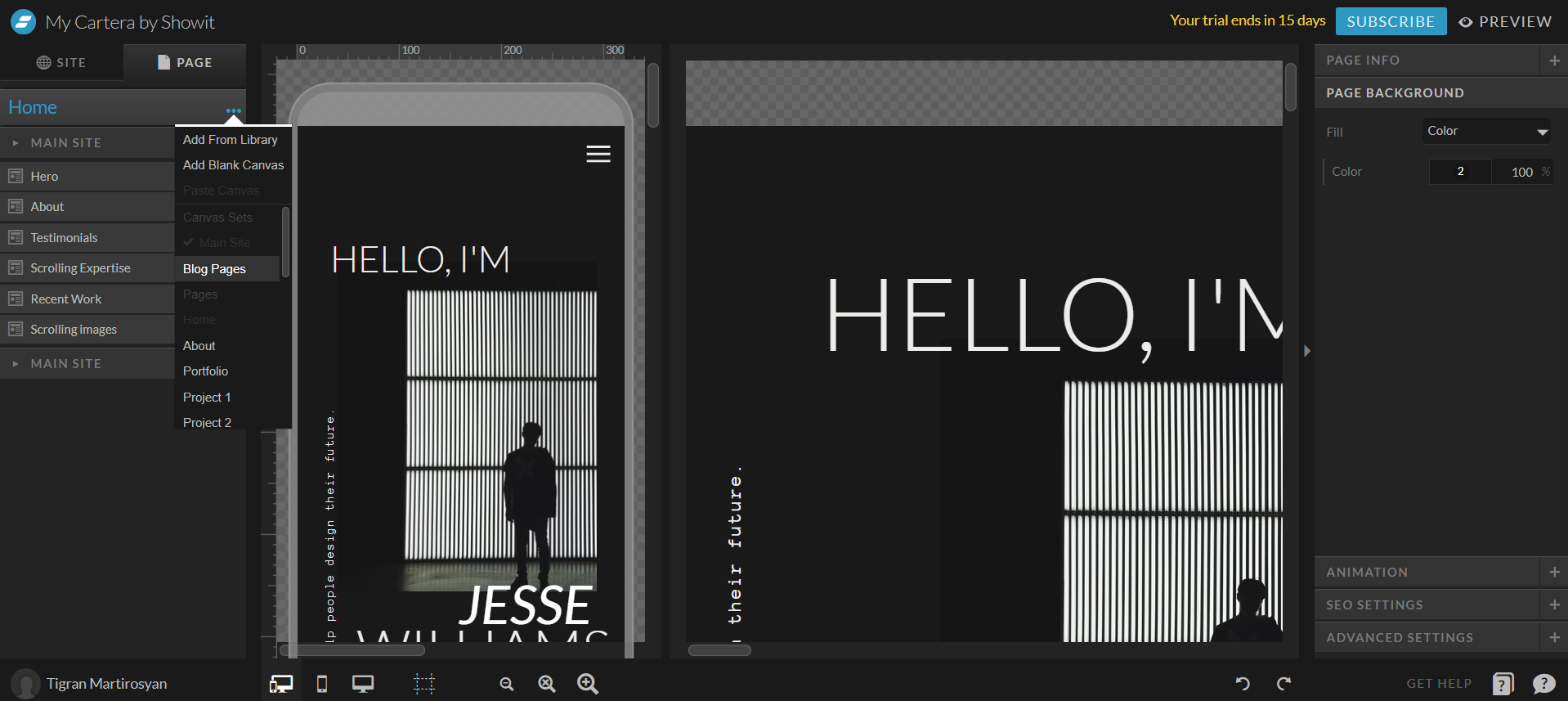
Google Sites’ editor, scoring 7.0, offers a user-friendly website builder that allows users to create and design websites without needing coding knowledge. It features drag-and-drop functionality, customizable templates, and easy integration with other Google services. However, its simplicity comes with limitations, such as a lack of advanced design customization options and limited third-party integrations compared to more sophisticated website builders.
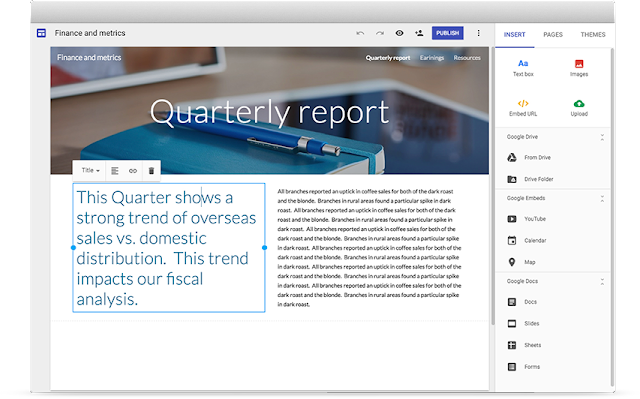
Mobile editor/app
 0
0
 0
0
🏆
Winner: None
. Unfortunately, neither Google Sites nor Showit offers a mobile editor or app for editing websites. This means that you cannot make changes to your website or manage its content from a mobile device. This could be a significant drawback if you need to make quick updates or changes on the go. Both platforms would benefit from developing a mobile app or editor to enhance their usability and convenience for users.
Product testing options
Product Testing OptionsAssesses the options for trying out platform features before commitment.Score Components:
- Trial quality (40%): Extent and usefulness of the trial or free version.
- Feature accessibility (30%): How many features are available to test.
- Trial duration (20%): Length of the trial period.
- Ease of transition (10%): Smoothness of moving from trial to paid plans.
 6.9
6.9
 8.3
8.3
Overall Result
:
Showit Wins
. Showit scores 8.3, outperforming Google Sites which scores 6.9. Showit offers a 14-day free trial with the possibility to test all premium features, and a 30-day money back guarantee. Google Sites, on the other hand, offers a free version and a 14-day free trial, but only allows testing of some premium features and does not offer a money-back guarantee.

|

|
|
|---|---|---|
|
Free Plan |
Yes | No |
|
Trial Duration |
14 days | 14 days |
|
Testing Premium Features |
Some features during free trial |
All features during free trial |
|
Money Back Guarantee |
No |
30 days |
Price
PriceLooks at the cost-effectiveness and value for money of each platform.Score Components:
- Plan value (40%): What each pricing tier offers.
- Transparency and clarity (30%): Clearness of pricing structures.
- Flexibility of plans (20%): Range of options to suit different budgets.
- Hidden costs (10%): Additional expenses not included in the plan.
 8.1
8.1
 7.9
7.9
Google Sites and Showit offer a range of pricing plans to cater to different user needs.
Google Sites offers per user pricing, making it a cost-effective option for small teams, while Showit’s pricing is more straightforward and may be more suitable for individual users or small businesses. Both platforms offer discounts for annual billing and have enterprise plans for larger organizations or high-traffic websites.

|

|
|
|---|---|---|
|
$0-$10 |
Business Starter ($7.20/month): This plan includes basic features suitable for individuals or small businesses, offering professional email through Gmail, 30GB of storage per user, and video meetings for up to 100 participants. It allows to manage 1 website and there is no limitation on number of pages. Value for price: 6.0 |
No offering at this amount. |
|
$10-$20 |
Business Standard ($14.40/month): Suitable for growing businesses, this plan provides 2 TB of storage per user, video meeting capacity for up to 150 participants with recording features, and access to smart booking pages and shared drives. It allows to manage 1 website and there is no limitation on number of pages. Value for price: 7.5 |
No offering at this amount. |
|
$20-$25 |
Business Plus ($21.60/month): Designed for larger businesses needing more robust capabilities, offering 5 TB of storage per user, advanced security options, and video meetings for up to 500 participants. It allows to manage 1 website and there is no limitation on number of pages. Value for price: 8.5 |
Showit ($24/month): Ideal for sites without a blog. Includes 20GB storage and secure certificate. Regular design backups stored for 7 days. Value for price: 6.0 |
|
$25-$30 |
No offering at this amount. |
Showit + Basic Starter Blog ($29/month): For new blogs. Includes everything in the Showit plan, plus blog-specific features. 20GB storage, up to 10k monthly visitors, daily backups stored for 30 days, pre-installed plugins (no additional plugins are permitted), 1 WordPress user. Value for price: 7.0 |
|
$30-$40 |
No offering at this amount. |
Showit + Advanced Blog ($39/month): For migrating or high-traffic blogs with custom plugin needs. Includes everything in the Basic Starter Blog plan, plus up to 25k monthly visits, unlimited number of plugins, unlimited number of WordPress users, Free advanced blog migration from WordPress or Squarespace and FTP access. Value for price: 8.0 |
|
$60-$70 |
No offering at this amount. |
Showit + Advanced Blog 50k ($69/month): Includes everything in the Showit + Advanced Blog plan, with possibility to install custom WordPress plugins, 30 GB storage, up to 50k visitors monthly, and possibility to migrate Squarespace and WordPress blog posts. Value for price: 8.5 |
|
$100+ |
No offering at this amount. |
Showit + Advanced Blog 100k ($129/month): Includes everything in the Showit + Advanced Blog plan, with possibility to install custom WordPress plugins, 50 GB storage, up to 100k visitors monthly, and possibility to migrate Squarespace and WordPress blog posts. Value for Price: 9.0 |
location. As a result in rare cases the prices displayed here can differ from the ones you see on their
websites.
Hosting quality
Hosting
qualityExamines the reliability and performance of the hosting solutions.Score Components:
- Uptime (40%): Consistency and reliability of website availability.
- Speed (30%): Loading times and performance.
- Bandwidth and storage (20%): Sufficiency of resources provided.
- Data centers (10%): Quality and distribution of hosting infrastructure.
 8.2
8.2
 7.3
7.3
🏆
Winner: Google Sites
Google Sites offers cloud-based managed hosting with a 99.9% uptime guarantee and a vast network of 21 global data centers. Showit, on the other hand, provides managed WordPress hosting with a 99% uptime guarantee, but does not disclose information about its data centers. Google Sites’ extensive infrastructure and transparency give it the edge in this category.

|

|
|
|---|---|---|
|
Do they offer hosting? |
Yes, basic storage with 100MB free per site, can be increased by upgrading to Google Workspace |
Yes, Managed wordpress hosting, with daily backups and 20GB storage |
|
Data Centers: |
Google operates a total of 21 data centers across the globe: 2 in Asia, 5 in Europe, 13 in US and 1 in South America |
Showit does not disclose any information about its data centers |
|
Type of hosting: |
Cloud based managed hosting |
Managed WordPress hosting |
|
Uptime: |
99.9% |
99.9% |
|
Uptime Guarantee: |
Yes, 99.9% |
Yes, 99% |
Website Speed Optimization
Website Speed OptimizationEvaluates optimization of website loading timesScore Components:
- PageSpeed Score (30%): Google’s score indicating performance optimization.
- Loading Time (30%): The average time until a website is fully interactive.
- Mobile Optimization (15%): Optimization effectiveness for mobile devices.
- Resource Optimization (15%): Optimizing images, scripts, and other heavy resources.
- CDN Usage (10%): Use of CDN to enhance speed across geolocations.
 3.3
3.3
 5.4
5.4
🏆 Winner: Showit
Both Google Sites and Showit have strategies in place for website speed optimization, but Showit has a higher website speed optimization score.

|

|
|
|---|---|---|
|
Focus |
Automated Optimization, CDN, Mobile Optimization, Browser Caching, Code Minification, Use of AMP |
Optimization plugins, Caching |
|
Performance Tools |
Google Lighthouse, PageSpeed Insights |
Google PageSpeed Insights Integration |
|
Key Strategies |
Automated Optimization, CDN, Mobile Optimization, Browser Caching, Code Minification, Use of AMP |
Optimization plugins, Caching |
|
Load Times |
Google does not disclose statistics about website Page Speed scores, or load times |
Load times and PageSpeed scores vary depending on optimization and website complexity |
|
Page Speed Scores Range |
Google does not disclose statistics about website Page Speed scores, or load times |
Load times and PageSpeed scores vary depending on optimization and website complexity |
|
Core Web Vitals Improvement |
Emphasis on LCP, FID, CLS improvements |
Showit does not disclose any information on their Core Web Vitals improvements |
Google Sites uses automated optimization, CDN, mobile optimization, browser caching, code minification, and the use of AMP as strategies for speed optimization. However, Google does not disclose statistics about website Page Speed scores or load times. They do place an emphasis on LCP, FID, and CLS improvements for Core Web Vitals.
Showit, on the other hand, uses optimization plugins and caching as their strategies for speed optimization. The load times and PageSpeed scores vary depending on optimization and website complexity. Showit does not disclose any information on their Core Web Vitals improvements. Despite the lack of disclosed information, Showit has a higher website speed optimization score compared to Google Sites.
Get a head start on website creation with AI
Create a custom website tailored to your business needs 10X faster with 10Web AI Website Builder!
Plugins and integrations
Plugins and integrationsMeasures the range and effectiveness of additional plugins and integrations.Score Components:
- Variety of options (40%): Range of available add-ons.
- Integration smoothness (30%): Ease of integrating plugins into the site.
- Quality of plugins (20%): Functionality and reliability of the options.
- Custom integration capabilities (10%): Support for custom or third-party integrations.
 6.4
6.4
 5.8
5.8
🏆 Winner: Google Sites.
Google Sites scores 6.4, offering a wide array of plugins and extensions to enhance website functionality. It integrates with various services like Elfsight and Common Ninja, providing functionalities like social media feeds, review displays, chat support, e-commerce tools, and various interactive widgets. Showit, scoring 5.8, also offers a variety of plugins primarily for users with the Advanced Blog plan, enhancing website functionality across SEO, spam protection, and more. However, the availability and use of these plugins are contingent upon the subscription tier, with higher tiers required for broader plugin compatibility and additional features. Notably, compatibility issues exist with certain WordPress plugins, necessitating alternative solutions or adjustments for optimal functionality.

Marketing Features
Design FunctionalitiesRepresents how well each platform allows for creative design and customization of websites.Score Components:
- Template Variety (30%): Range and quality of design templates.
- Customization (30%): Flexibility and options for design alterations.
- User Interface (20%): Ease and intuitiveness of the design process.
- Responsiveness (10%): Adaptability to different devices and screen sizes.
- Innovation (10%): Unique design features and tools.
 2.6
2.6
 7.2
7.2
🏆
Overall Winner: Showit
. Showit offers a more comprehensive set of marketing features, including SEO tools, email marketing, blogging, social media integration, analytics and reporting, and ads and promotions. Google Sites, while offering some of these features, lacks in areas such as email marketing, blogging, and ads and promotions.

|

|
|
|---|---|---|
|
SEO Tools |
Basic SEO settings |
Comprehensive SEO tools |
|
Email Marketing |
No |
Yes, through third-party integrations |
|
Blogging |
No |
Yes |
|
Social Media Integration |
Basic social media integration |
Advanced social media integration |
|
Analytics and Reporting |
Google Analytics integration |
Google Analytics integration |
|
Ads and Promotions |
No |
Yes, through third-party integrations |
Customer Support
Customer supportEvaluates the quality and availability of support options.Score Components:
- Response time (40%): Speed of support responses.
- Support quality (30%): Effectiveness and helpfulness of the support.
- Availability (20%): Range of support channels (phone, chat, email).
- Resource richness (10%): Quality of self-help and educational materials.
 7.2
7.2
 6.4
6.4
🏆 Winner: Google Sites
. Comparing Google Sites vs Showit, Google Sites takes the lead in this category with its comprehensive support options. Google Sites offers a range of self-service resources, including a Help Center and community forums, which are accessible to all users. For Google Workspace customers, direct support is available through phone, email, and live chat, with 24/7 support for critical issues depending on the subscription tier. This extensive support network ensures that users can find help quickly and efficiently.
Showit, on the other hand, provides customer support via email and chat from Monday to Friday, 7 AM to 11 PM Arizona Time, with limited support on weekends. While Showit is praised for its quick response times during business hours, it lacks the 24/7 support availability that Google Sites offers to its Workspace customers. This makes Google Sites a more reliable option for users who may need assistance at any time.
Security
SecurityLooks at the platforms’ security measures and data protection.Score Components:
- Data protection (40%): Safeguards for user and customer data.
- SSL and encryption (30%): Implementation of secure connections.
- Compliance (20%): Adherence to industry security standards.
- Regular updates (10%): Frequency of security updates and patches.
 9.3
9.3
 8.3
8.3
🏆
Winner: Google Sites
. Google Sites, part of the Google Workspace, offers robust security measures including SSL encryption, two-factor authentication, and automatic malware scanning. It also benefits from Google’s regular security updates and compliance with international data protection standards. Google’s infrastructure provides DDoS protection and data redundancy, ensuring a secure environment for website creators and visitors.
Showit also prioritizes user data privacy and security, adhering to GDPR guidelines and employing Amazon’s S3 for secure and redundant data storage. It provides robust security features for all hosted websites, including free SSL certificates and automated backups. However, it falls slightly short when compared to the comprehensive security measures offered by Google Sites.
AI Capabilities
AI capabilitiesMeasures the effectiveness of AI-driven features and tools.Score Components:
- Automation efficiency (40%): Impact of AI on streamlining processes.
- Personalization (30%): AI-driven customization for users or customers.
- AI-Assisted design (20%): Role of AI in website design and functionality.
- Data analysis (10%): Use of AI in interpreting user data and analytics.
 0
0
 0
0

|

|
|
|---|---|---|
|
Personalized Design |
|
|
|
SEO Optimization |
|
|
|
Customer Behavior Analysis |
|
|
|
Sales Predictions |
|
|
|
Inventory Management |
|
|
|
Content Generation |
|
|
🏆 Winner: None
. Neither Google Sites nor Showit offer AI capabilities. Both platforms focus on providing a user-friendly interface for website building, without the integration of AI features. This makes them suitable for users who prefer a straightforward, hands-on approach to website design and management.
User Management
User ManagementAssesses the platforms’ capabilities in managing user roles, permissions, and accessibility.Score Components:
- Role Customization (40%): Flexibility in creating and defining user roles and
permissions. - Ease of Management (30%): User interface and tools for managing users.
- Access Control (20%): Effectiveness of access control measures for different user
levels. - Scalability (10%): Ability to manage a growing number of users efficiently.
 7.8
7.8
 6.7
6.7
🏆 Winner: Google Sites
. Google Sites and Showit offer different approaches to user management.
- Google Sites allows multiple users to collaborate with different roles, including Owners, who have full control, and Editors, who can modify content but not site settings. There’s no strict limit on the number of users who can edit a site, allowing flexibility in management and development. Viewers can only see the site, with no editing permissions. This structure supports collaborative website building with varied levels of access and control for different users.
- Showit allows only one user on lower plans. On its Showit + Advanced Blog plan, the platform allows an unlimited number of users with different access levels.
Showit User Roles and Access Levels:
| Role | Description | Access Highlights |
|---|---|---|
| Administrator | Users with full access to all administration features, including Elementor settings. | Can edit all content, Access to Elementor settings, Can install plugins and themes, Can manage users |
| Editor | Users who can manage and publish content including pages and posts. | Can edit pages/posts created with Elementor, Cannot access Elementor settings, Can manage categories, tags, and links, Can moderate comments |
| Author | Users who can publish and manage their own posts. | Can create posts with Elementor, Cannot edit pages, Limited access to media library, Cannot access Elementor settings |
| Contributor | Users who can write and manage their own posts but cannot publish them. | Can create content with Elementor, Cannot publish or edit pages, No access to Elementor settings, Submissions require review by higher-level roles |
Additional Features

|

|
|
|---|---|---|
|
SSL Certificate |
|
|
|
Custom Domain |
|
|
|
Free Custom Domain Included |
|
|
|
International Domains |
|
|
|
Mobile Responsive |
|
|
|
Page Speed |
|
|
|
Website Builder Mobile App |
|
|
|
Convert a Website To An App |
|
|
|
Website Analytics |
|
|
|
Multilingual Sites |
|
|
|
Multiple Users |
|
|
User Feedback
Users consistently praise Google Workspace, particularly Google Sites, for its seamless integration, ease of use, and collaborative features, making it a go-to solution for various professional and educational needs. The platform’s simplicity and user-friendly interface are lauded, enabling effortless website creation and sharing of information within organizations. While some users desire more customization options and additional features, overall, Google Workspace remains highly valued for its versatility and streamlined workflow facilitation.
Showit, although not reviewed on G2, is designed primarily for creative professionals such as photographers, designers, and bloggers. Its unique dual canvas interface allows for the independent design of mobile and desktop views, providing a high degree of customization and control over the website’s appearance on different devices. The platform’s seamless integration with WordPress for blogging makes it a popular choice for users who want the design flexibility of Showit for their site’s look and feel, with the powerful blogging capabilities of WordPress.
The making of this blog
We followed a clear, step-by-step process to write and research this article.
FAQ
Which platform is better for creative professionals, Google Sites or Showit?
Can I use Google Sites for ecommerce?
How do Google Sites and Showit compare in terms of ease of use?
Which platform offers better customer support, Google Sites or Showit?
Are there any AI capabilities in Google Sites or Showit?
Which platform is more secure, Google Sites or Showit?
Can I manage multiple users with Google Sites or Showit?
How do Google Sites and Showit perform in website speed optimization?
Which platform is better for marketing features?
What are the pricing options for Google Sites and Showit?










